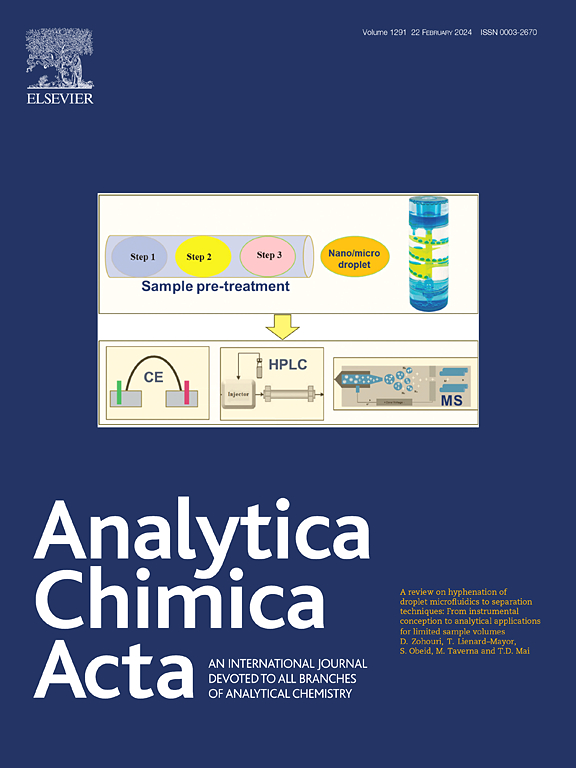Assessing the hyphenation of ion chromatography with optical emission spectrometry for trace analysis of oxyhalide bromine and chlorine species
IF 5.7
2区 化学
Q1 CHEMISTRY, ANALYTICAL
引用次数: 0
Abstract
Background
The increased application of oxidative water treatment is associated with the presence of halogenated disinfection by-products (DBPs) in aqueous systems. Due to their hazard potential, permanent measurements of selected analytes are required to monitor their compliance with regulatory limits and guidelines. However, the simultaneous acquisition of alarming inorganic oxyhalide species by conventional ion chromatography (IC) is often impeded by co-elution of interfering analyte or matrix components, especially when DBPs of multiple halogens are present in solution. This necessitates a complementary, orthogonal detection setup that allows for an element-specific analysis.
Results
The present work evaluates the hyphenation of IC with optical emission spectrometry (ICP-OES) for the simultaneous quantification of five prominent bromine and chlorine species, namely , , , and , at trace concentrations ranging from 2.5 to 100 μmol L−1 for Br species and 5–100 μmol L−1 for Cl species. It is shown that ICP-OES detection in the vacuum UV region below 170 nm leads to higher sensitivity for Br species, with showing a significantly () stronger signal response than . The developed method enables the selective quantification of co-eluting (oxy-)halides and shows excellent linearity (R2 0.999) and coefficients of variation of the procedure Vx0 < 5 % for all analytes. Limits of detection below 100 μg L−1 were achieved, in conjunction with mean recovery rates of 98 4 % in challenging matrices.
Significance
For the first time, Br and Cl speciation was successfully achieved by using IC-ICP-OES hyphenation. The results highlight the robustness and applicability of the developed method exemplarily for oxyhalide speciation, clearly differentiating species-specific behavior of halogens in an emission spectrometer. This hyphenation technique generally enables solving complex separation problems by simultaneously evaluating different spectral properties, hence demonstrating to be a valid alternative to ICP-MS, especially for pool and spa water quality monitoring.

离子色谱-发射光谱法测定氧化卤化物、溴和氯痕量分析中的连字符
氧化水处理应用的增加与水系统中卤化消毒副产物(DBPs)的存在有关。由于其潜在的危害,需要对选定的分析物进行永久测量,以监测其是否符合法规限制和指导方针。然而,通过传统离子色谱法(IC)同时获取令人担忧的无机氧化卤化物常常受到干扰分析物或基质成分的共同洗脱的阻碍,特别是当溶液中存在多种卤素的dbp时。这就需要一个互补的、正交的检测设置,以允许特定元素的分析。结果采用ICP-OES同时测定5种主要的溴和氯,即Br在2.5 ~ 100 μmol L-1范围内,Cl在5 ~ 100 μmol L-1范围内。结果表明,ICP-OES在170 nm以下的真空紫外区检测Br的灵敏度更高,信号响应明显强于真空紫外区。所建立的方法能够选择性地定量共洗脱(氧-)卤化物,并具有良好的线性(R2 0.999)和变异系数Vx0 <;所有分析物5%。在挑战性基质中,检测限低于100 μg L-1,平均回收率为98.4%。意义首次成功地利用IC-ICP-OES连字符实现了Br和Cl的形态。结果突出了该方法的稳健性和适用性,以氧卤化物物种形成为例,清楚地区分了发射光谱仪中卤素的物种特异性行为。这种连线技术通常可以通过同时评估不同的光谱特性来解决复杂的分离问题,因此证明是ICP-MS的有效替代方案,特别是用于游泳池和温泉水质监测。
本文章由计算机程序翻译,如有差异,请以英文原文为准。
求助全文
约1分钟内获得全文
求助全文
来源期刊

Analytica Chimica Acta
化学-分析化学
CiteScore
10.40
自引率
6.50%
发文量
1081
审稿时长
38 days
期刊介绍:
Analytica Chimica Acta has an open access mirror journal Analytica Chimica Acta: X, sharing the same aims and scope, editorial team, submission system and rigorous peer review.
Analytica Chimica Acta provides a forum for the rapid publication of original research, and critical, comprehensive reviews dealing with all aspects of fundamental and applied modern analytical chemistry. The journal welcomes the submission of research papers which report studies concerning the development of new and significant analytical methodologies. In determining the suitability of submitted articles for publication, particular scrutiny will be placed on the degree of novelty and impact of the research and the extent to which it adds to the existing body of knowledge in analytical chemistry.
 求助内容:
求助内容: 应助结果提醒方式:
应助结果提醒方式:


